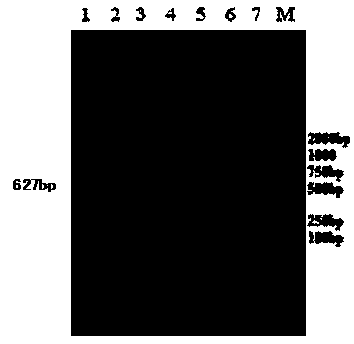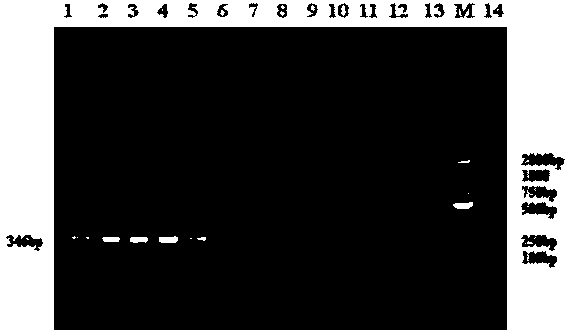Nested PCR (polymerase chain reaction) detection method for mycoplasma hyorhinis
A technology of mycoplasma hyorhinosum and primer pairs, applied in the biological field, can solve the problems of long detection time and achieve the effects of short quarantine period, easy promotion and strong specificity
- Summary
- Abstract
- Description
- Claims
- Application Information
AI Technical Summary
Problems solved by technology
Method used
Image
Examples
Embodiment 1
[0033] Embodiment 1, the nested PCR detection method of Mycoplasma hyorhinus of the present invention mainly comprises the following steps:
[0034] 1) Extract the DNA of Mycoplasma hyorrhinosus samples and store at low temperature for future use;
[0035] The DNA of the Mycoplasma hyorrhinos sample used in the present invention can be extracted by conventional methods, and the specific method is to carry out the following steps after extracting the swine lung tissue containing Mycoplasma hyorrhinosus:
[0036] 1) Add 100 mg of tissue to 600 μl of protein lysate, then add 3 μl of proteinase K (20 mg / ml), 3 μl of RNase inhibitor (10 mg / ml), mix well, and water bath at 55°C for 2-4 hours, shaking several times during this period.
[0037] 2) Add an equal volume of phenol:chloroform:isoamyl alcohol (25:24:1), shake gently for 10min, and centrifuge at 1,2000rpm for 5min.
[0038] 3) Take the supernatant (about 300 μl), add 600 μl of chloroform, and centrifuge at 1,2000 rpm for 5 ...
Embodiment 2
[0071] Example 2, in order to verify the specificity of Mycoplasma hyorrhea, the electrophoresis detection method can be used to detect Mycoplasma flocculum, Mycoplasma hyos synovium, Mycoplasma hyopneumoniae, Mycoplasma gallisepticum, Actinobacillus pleuropneumoniae, swine fever virus, swine fever virus, respectively. Influenza virus, porcine circovirus and Mycoplasma hyorrhinos negative and positive controls were tested. The gel electrophoresis results of the amplified products of each strain are shown in figure 1 , the results showed that Mycoplasma hyorhinosus could amplify a 346bp band, while the negative control and other strains did not amplify a specific band.
Embodiment 3
[0072] Embodiment 3, the sensitivity test of common double primer PCR
[0073] 1. Through the determination of the discoloration unit of Mycoplasma hyorrhinosus, the content of Mycoplasma hyorrhinosus was measured to be 10 9 CCU / mL;
[0074] 2. Dilute the above-mentioned Mycoplasma hyorrhea cell stock solution as: 10 7 CCU / mL, 10 6 CCU / mL, 10 5 CCU / mL, 10 4 CCU / mL, 10 3 CCU / mL, 10 2 CCU / mL, extract the DNA of each bacterial body, take 1 μl
[0075] As a template, only one PCR amplification was performed with specific primers Mhr P01 / P02, and the electrophoresis results after amplification were shown in figure 2 . The same results were obtained by repeating the amplification three times.
[0076] figure 2 , M is a 2000bp DNA marker; 1-6 represent DNA templates of 10 7 CCU / mL, 10 6 CCU / mL, 10 5 CCU / mL, 10 4 CCU / mL, 10 3 CCU / mL, 10 2 A PCR amplification product of Mycoplasma hyorhinosa at CCU / mL. figure 2 showed that the minimum detectable pathogens were 10 fo...
PUM
 Login to View More
Login to View More Abstract
Description
Claims
Application Information
 Login to View More
Login to View More - Generate Ideas
- Intellectual Property
- Life Sciences
- Materials
- Tech Scout
- Unparalleled Data Quality
- Higher Quality Content
- 60% Fewer Hallucinations
Browse by: Latest US Patents, China's latest patents, Technical Efficacy Thesaurus, Application Domain, Technology Topic, Popular Technical Reports.
© 2025 PatSnap. All rights reserved.Legal|Privacy policy|Modern Slavery Act Transparency Statement|Sitemap|About US| Contact US: help@patsnap.com



